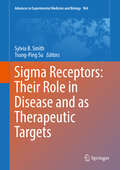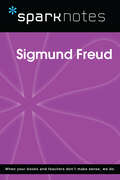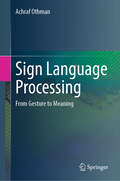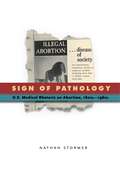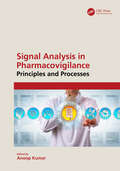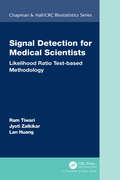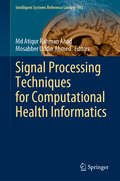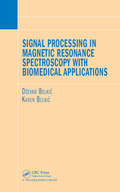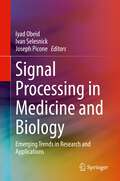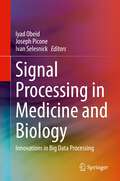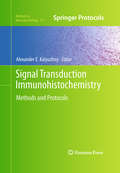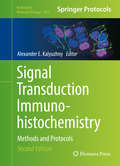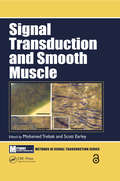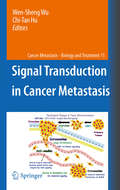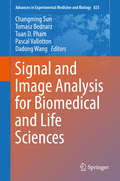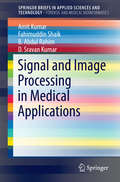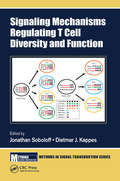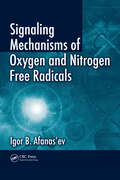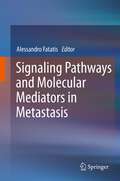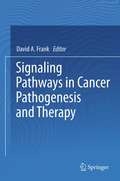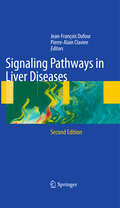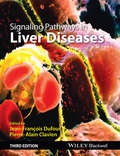- Table View
- List View
Sigma Receptors: Their Role in Disease and as Therapeutic Targets
by Sylvia B. Smith Tsung-Ping SuOriginally confused with opioid receptors and then orphan receptors with no biological function, Sigma Receptors are now recognized as relevant to many degenerative diseases with remarkable potential as therapeutic targets. In this text, new information about the structure of sigma 1 receptor, its binding sites are provided as well as its expression in many cell types. It’s putative role in degenerative neuronal diseases including amyotrophic lateral sclerosis, Alzheimer’s disease, Parkinson’s disease, Huntington’s disease, pain, drug addiction and locomotor activity. Their roles in possible treatments for blinding retinal diseases emphasize the tremendous far-reaching potential for ligands for these receptors. Exciting breakthroughs in this dynamic field in the last decade are reported herein, which will guide future investigators in determining the full potential of this unique, yet abundantly expressed protein.
Sigmund Freud (SparkNotes Biography Guide)
by SparkNotesSigmund Freud (SparkNotes Biography Guide) Making the reading experience fun! SparkNotes Biography Guides examine the lives of historical luminaries, from Alexander the Great to Virginia Woolf. Each biography guide includes:An examination of the historical context in which the person lived A summary of the person&’s life and achievements A glossary of important terms, people, and events An in-depth look at the key epochs in the person&’s career Study questions and essay topics A review test Suggestions for further reading Whether you&’re a student of history or just a student cramming for a history exam, SparkNotes Biography guides are a reliable, thorough, and readable resource.
Sign Language Processing: From Gesture to Meaning
by Achraf OthmanIn a world where communication is key to human connection, understanding, and learning from one another, the book investigates the rich and intricate world of sign languages, highlighting the fascinating complexities of visual-spatial languages and their unique role in bridging the gap between hearing and deaf communities through information and communication technology. The book takes a journey through the evolution of sign language processing tools while exploring the cutting-edge techniques used to decipher, analyze, and process them, from the fundamentals of sign language structure and the nuances of non-manual signals to the latest developments in computational linguistics (corpora design, annotation tools, and notation systems), sign language recognition, and machine/deep learning applications. With a mission to reveal the silent language of expression, the author provides a captivating and thought-provoking look into a world often overlooked yet teeming with life and meaning. Offering a comprehensive and engaging overview of the current state of sign language research as well as its prospects, this monograph is an introduction resource for computer scientists, linguistics, educators, academics and sign language interpreters alike. This monograph is an invitation to discover the incredible potential of sign languages to transform human communication, promote inclusivity, and shape the future of technology. The readers will gain a deeper appreciation of the beauty and complexity of sign languages through technology, and they will be inspired to embrace the power of visual communication in our increasingly diverse and interconnected world.
Sign of Pathology: U.S. Medical Rhetoric on Abortion, 1800s–1960s (RSA Series in Transdisciplinary Rhetoric #1)
by Nathan StormerMuch of the political polarization that grips the United States is rooted in the so-called culture wars, and no topic defines this conflict better than the often contentious and sometimes violent debate over abortion rights. In Sign of Pathology, Nathan Stormer reframes our understanding of this conflict by examining the medical literature on abortion from the 1800s to the 1960s. Often framed as an argument over a right to choose versus a right to life, our current understanding of this conflict is as a contest over who has the better position on reproductive biology. Against this view, Sign of Pathology argues that, as it became a medical problem, abortion also became a template, more generally, for struggling with how to live—far exceeding discussions of the merits of providing abortions or how to care for patients. Abortion practices (and all the legal, moral, and ideological entanglements thereof) have rested firmly at the center of debate over many fundamental institutions and concepts—namely, the individual, the family, the state, human rights, and, indeed, the human. Medical rhetoric, then, was decisive in cultivating abortion as a mode of cultural critique, even weaponizing it for discursive conflict on these important subjects, although the goal of the medical practice of abortion has never been to establish this kind of struggle. Stormer argues that the medical discourse of abortion physicians transformed the state of abortion into an indicator that the culture was ill, attacking itself during and through pregnancy in a wrongheaded attempt to cope with reproduction.
Signal Analysis in Pharmacovigilance: Principles and Processes
by Anoop KumarThis book provides detailed concepts and information on principles and processes of signal analysis in pharmacovigilance along with case studies. It covers the fundamental concepts and principles of pharmacovigilance, emphasizing the need for robust signal detection and analysis methods. The book reviews the diverse array of databases and tools employed for signal detection, including electronic health records (EHRs), social media mining, claims data, and distributed data networks. In turn, the book discusses the application of molecular dynamics, molecular docking, and the use of the FDA Adverse Event Reporting System (FAERS) database in signal analysis. Toward the end, the book explores the identification, validation, and assessment of signals associated with vaccines. This book is useful for graduate, post-graduate students of pharmaceutical sciences, and scientists in pharmacology research and drug development.
Signal Detection for Medical Scientists: Likelihood Ratio Test-based Methodology (Chapman & Hall/CRC Biostatistics Series)
by Ram Tiwari Jyoti Zalkikar Lan HuangSignal Detection for Medical Scientists: Likelihood Ratio Based Test-Based Methodology presents the data mining techniques with focus on likelihood ratio test (LRT) based methods for signal detection. It emphasizes computational aspect of LRT methodology and is pertinent for first-time researchers and graduate students venturing into this interesting field. The book is written as a reference book for professionals in pharmaceutical industry, manufactures of medical devices, and regulatory agencies. The book deals with the signal detection in drug/device evaluation, which is important in the post-market evaluation of medical products, and in the pre-market signal detection during clinical trials for monitoring procedures. It should also appeal to academic researchers, and faculty members in mathematics, statistics, biostatistics, data science, pharmacology, engineering, epidemiology, and public health. Therefore, this book is well suited for both research and teaching. Key Features: Includes a balanced discussion of art of data structure, issues in signal detection, statistical methods and analytics, and implementation of the methods. Provides a comprehensive summary of the LRT methods for signal detection including the basic theory and extensions for varying datasets that may be large post-market data or pre-market clinical trial data. Contains details of scientific background, statistical methods, and associated algorithms that a reader can quickly master the materials and apply methods in the book on one’s own problems
Signal Processing Techniques for Computational Health Informatics (Intelligent Systems Reference Library #192)
by Md Atiqur Rahman Ahad Mosabber Uddin AhmedThis book focuses on signal processing techniques used in computational health informatics. As computational health informatics is the interdisciplinary study of the design, development, adoption and application of information and technology-based innovations, specifically, computational techniques that are relevant in health care, the book covers a comprehensive and representative range of signal processing techniques used in biomedical applications, including: bio-signal origin and dynamics, sensors used for data acquisition, artefact and noise removal techniques, feature extraction techniques in the time, frequency, time–frequency and complexity domain, and image processing techniques in different image modalities.Moreover, it includes an extensive discussion of security and privacy challenges, opportunities and future directions for computational health informatics in the big data age, and addresses the incorporation of recent techniques from the areas of artificial intelligence, deep learning and human–computer interaction. The systematic analysis of the state-of-the-art techniques covered here helps to further our understanding of the physiological processes involved and expandour capabilities in medical diagnosis and prognosis.In closing, the book, the first of its kind, blends state-of-the-art theory and practices of signal processing techniques inthe health informatics domain with real-world case studies building on those theories. As a result, it can be used as a text for health informatics courses to provide medics with cutting-edge signal processing techniques, or to introducehealth professionals who are already serving in this sector to some of the most exciting computational ideas that paved the way for the development of computational health informatics.
Signal Processing and Machine Learning for Biomedical Big Data
by Ervin Sejdic Tiago H. FalkWithin the healthcare domain, big data is defined as any ``high volume, high diversity biological, clinical, environmental, and lifestyle information collected from single individuals to large cohorts, in relation to their health and wellness status, at one or several time points.'' Such data is crucial because within it lies vast amounts of invaluable information that could potentially change a patient's life, opening doors to alternate therapies, drugs, and diagnostic tools. Signal Processing and Machine Learning for Biomedical Big Data thus discusses modalities; the numerous ways in which this data is captured via sensors; and various sample rates and dimensionalities. Capturing, analyzing, storing, and visualizing such massive data has required new shifts in signal processing paradigms and new ways of combining signal processing with machine learning tools. This book covers several of these aspects in two ways: firstly, through theoretical signal processing chapters where tools aimed at big data (be it biomedical or otherwise) are described; and, secondly, through application-driven chapters focusing on existing applications of signal processing and machine learning for big biomedical data. This text aimed at the curious researcher working in the field, as well as undergraduate and graduate students eager to learn how signal processing can help with big data analysis. It is the hope of Drs. Sejdic and Falk that this book will bring together signal processing and machine learning researchers to unlock existing bottlenecks within the healthcare field, thereby improving patient quality-of-life. Provides an overview of recent state-of-the-art signal processing and machine learning algorithms for biomedical big data, including applications in the neuroimaging, cardiac, retinal, genomic, sleep, patient outcome prediction, critical care, and rehabilitation domains. Provides contributed chapters from world leaders in the fields of big data and signal processing, covering topics such as data quality, data compression, statistical and graph signal processing techniques, and deep learning and their applications within the biomedical sphere. This book’s material covers how expert domain knowledge can be used to advance signal processing and machine learning for biomedical big data applications.
Signal Processing in Magnetic Resonance Spectroscopy with Biomedical Applications
by Dzevad Belkic Karen BelkicAddressing the critical need in clinical oncology for robust and stable signal processing in magnetic resonance spectroscopy (MRS), Signal Processing in Magnetic Resonance Spectroscopy with Biomedical Applications explores cutting-edge theory-based innovations for obtaining reliable quantitative information from MR signals for cancer diagnostics. By defining the natural framework of signal processing using the well-established theory of quantum physics, the book illustrates how advances in signal processing can optimize MRS. <p> The authors employ the fast Padé transform (FPT) as the unique polynomial quotient for the spectral analysis of MR time signals. They prove that residual spectra are necessary but not sufficient criteria to estimate the error invoked in quantification. Instead, they provide a more comprehensive strategy that monitors constancy of spectral parameters as one of the most reliable signatures of stability and robustness of quantification. The authors also use Froissart doublets to unequivocally distinguish between genuine and spurious resonances in both noise-free and noise-corrupted time signals, enabling the exact reconstruction of all the genuine spectral parameters. They show how the FPT resolves and quantifies tightly overlapped resonances that are abundantly seen in MR spectra generated using data from encoded time signals from the brain, breast, ovary, and prostate. <p> Written by a mathematical physicist and a clinical scientist, this book captures the multidisciplinary nature of biomedicine. It examines the remarkable ability of the FPT to unambiguously quantify isolated, tightly overlapped, and nearly confluent resonances.
Signal Processing in Medicine and Biology: Emerging Trends in Research and Applications
by Iyad Obeid Ivan Selesnick Joseph PiconeThis book covers emerging trends in signal processing research and biomedical engineering, exploring the ways in which signal processing plays a vital role in applications ranging from medical electronics to data mining of electronic medical records. Topics covered include statistical modeling of electroencephalograph data for predicting or detecting seizure, stroke, or Parkinson’s; machine learning methods and their application to biomedical problems, which is often poorly understood, even within the scientific community; signal analysis; medical imaging; and machine learning, data mining, and classification. The book features tutorials and examples of successful applications that will appeal to a wide range of professionals and researchers interested in applications of signal processing, medicine, and biology.
Signal Processing in Medicine and Biology: Innovations in Big Data Processing
by Iyad Obeid Ivan Selesnick Joseph PiconeSignal Processing in Medicine and Biology: Innovations in Big Data Processing provides an interdisciplinary look at state-of-the-art innovations in biomedical signal processing, especially as it applies to large data sets and machine learning. Chapters are presented with detailed mathematics and complete implementation specifics so that readers can completely master these techniques. The book presents tutorials and examples of successful applications and will appeal to a wide range of professionals, researchers, and students interested in applications of signal processing, medicine, and biology at the intersection between healthcare, engineering, and computer science.
Signal Transduction Immunohistochemistry
by Alexander E. KalyuzhnyUnlike detecting constitutively expressed targets, immunohistochemical detection of labile, low abundance, and short-lived signal transduction molecules can be a very difficult task. In Signal Transduction Immunohistochemistry: Methods and Protocols, IHC experts contribute detailed protocols addressing the numerous challenges of signal-transduction immunohistochemistry (ST-IHC). Beginning with a set of introductory chapters, the volume moves on to cover techniques used for the preservation of antigens and their unmasking, protocols in digital imaging and image analysis of stained cells and tissues, high-throughput data collection and data analysis, and techniques used in neuroscience as well as cancer and stem cell research. Written in the highly successful Methods in Molecular BiologyTM series format, chapters include brief introductions to their respective topics, lists of the necessary materials and reagents, step-by-step, readily reproducible laboratory protocols, and tips on troubleshooting and avoiding known pitfalls. Authoritative and practical, Signal Transduction Immunohistochemistry: Methods and Protocols serves as an ideal guide for novices and as a bastion of inspiring ideas to be exploited by experienced researchers on the lookout for new experimental tricks and hints.
Signal Transduction Immunohistochemistry
by Alexander E. KalyuzhnyUnlike detecting constitutively expressed targets, immunohistochemical detection of labile, low abundance, and short-lived signal transduction molecules can be a very difficult task. In Signal Transduction Immunohistochemistry: Methods and Protocols, IHC experts contribute detailed protocols addressing the numerous challenges of signal-transduction immunohistochemistry (ST-IHC). Beginning with a set of introductory chapters, the volume moves on to cover techniques used for the preservation of antigens and their unmasking, protocols in digital imaging and image analysis of stained cells and tissues, high-throughput data collection and data analysis, and techniques used in neuroscience as well as cancer and stem cell research. Written in the highly successful Methods in Molecular Biology(tm) series format, chapters include brief introductions to their respective topics, lists of the necessary materials and reagents, step-by-step, readily reproducible laboratory protocols, and tips on troubleshooting and avoiding known pitfalls. Authoritative and practical, Signal Transduction Immunohistochemistry: Methods and Protocols serves as an ideal guide for novices and as a bastion of inspiring ideas to be exploited by experienced researchers on the lookout for new experimental tricks and hints.
Signal Transduction and Smooth Muscle (Methods in Signal Transduction Series)
by Mohamed Trebak and Scott EarleyAll hollow organs, such as blood vessels, the gastrointestinal tract, airways, male and female reproductive systems, and the urinary bladder are primarily composed of smooth muscle. Such organs regulate flow, propulsion and mixing of luminal contents and storage by the contraction and relaxation of smooth muscle cells. Smooth muscle cells respond to numerous inputs, including pressure, shear stress, intrinsic and extrinsic innervation, hormones and other circulating molecules, as well as autocrine and paracrine factors. This book is a review of smooth muscle cell regulation in the cardiovascular, reproductive, GI, and other organ systems with emphasis on calcium and receptor signaling. Key selling features: Focuses on smooth muscles of different types Describes ion channel signaling mechanisms Reviews calcium and receptor signaling Includes novel, cutting-edge methodologies Summarizes studies of mice with genetically encoding sensors in smooth muscle Chapter 9 of this book is freely available as a downloadable Open Access PDF at http://www.taylorfrancis.com under a Creative Commons Attribution (CC-BY) 4.0 license.
Signal Transduction in Cancer Metastasis
by Wen-Sheng Wu Chi-Tan HuThe poor prognosis and high mortality for cancer patients are majorly ascribed to tumor metastasis, one of the most complicated pathological processes. Elucidation of molecular mechanisms for metastasis is essential for management and prevention of this lethal condition. In the book to be published, we take comprehensive review in regard with the signal mechanisms responsible for triggering a series of phenotypical changes of primary tumor which may lead to final colonization of the tumor in a second home. Specifically, the initial stage of tumor metastasis will be highlighted. The complex tumor microenvironment accumulate a lot of growth factors, inflammatory cytokines and extracellular matrix which may turn into a group of potent metastatic factors. An integrated and sustained signaling induced by these metastatic factors may trigger EMT, migration and invasion of primary tumor into surround tissue. Blokcade of these signal pathways is the most effective approach for prevention of
Signal Transduction in the Retina (Methods in Signal Transduction Series)
by Steven J. Fliesler Oleg G. KisselevIn the twenty-first century, we are just beginning to understand more clearly the enormous diversity and complexity of signaling processes in the retina. Integrating advances in the biochemistry, cell biology, physiology, and physics of phototransduction, Signal Transduction in the Retina presents the methodologies and experimental approache
Signal and Image Analysis for Biomedical and Life Sciences
by Changming Sun Tomasz Bednarz Tuan D. Pham Pascal Vallotton Dadong WangWith an emphasis on applications of computational models for solving modern challenging problems in biomedical and life sciences, this book aims to bring collections of articles from biologists, medical/biomedical and health science researchers together with computational scientists to focus on problems at the frontier of biomedical and life sciences. The goals of this book are to build interactions of scientists across several disciplines and to help industrial users apply advanced computational techniques for solving practical biomedical and life science problems. This book is for users in the fields of biomedical and life sciences who wish to keep abreast with the latest techniques in signal and image analysis. The book presents a detailed description to each of the applications. It can be used by those both at graduate and specialist levels.
Signal and Image Processing Techniques for the Development of Intelligent Healthcare Systems
by V. Rajinikanth E. PriyaThis book comprehensively reviews the various automated and semi-automated signal and image processing techniques, as well as deep-learning-based image analysis techniques, used in healthcare diagnostics.It highlights a range of data pre-processing methods used in signal processing for effective data mining in remote healthcare, and discusses pre-processing using filter techniques, noise removal, and contrast-enhanced methods for improving image quality.The book discusses the status quo of artificial intelligence in medical applications, as well as its future. Further, it offers a glimpse of feature extraction methods for reducing dimensionality and extracting discriminatory information hidden in biomedical signals. Given its scope, the book is intended for academics, researchers and practitioners interested in the latest real-world technological innovations.
Signal and Image Processing in Medical Applications
by Amit Kumar Fahimuddin Shaik B Abdul Rahim D. Sravan KumarThis book highlights recentfindings on and analysesconducted on signalsand images in the area of medicine. The experimental investigations involve a variety of signalsand images and theirmethodologies range from very basic to sophisticated methods. The bookexplains how signal and image processing methods can be used to detect andforecast abnormalities in an easy-to-followmanner, offering a valuable resource for researchers, engineers,physicians and bioinformatics researchers alike.
Signaling Mechanisms Regulating T Cell Diversity and Function (Methods in Signal Transduction Series)
by Jonathan Soboloff; Dietmar J. KappesT cells play a vital role mediating adaptive immunity, a specific acquired resistance to an infectious agent produced by the introduction of an antigen. There are a variety of T cell types with different functions. They are called T cells, because they are derived from the thymus gland. This volume discusses how T cells are regulated through the operation of signaling mechanisms. Topics covered include positive and negative selection, early events in T cell receptor engagement, and various T cell subsets.
Signaling Mechanisms of Oxygen and Nitrogen Free Radicals
by Igor B. Afanas'evOnce the existence of free radicals was proven, an avalanche of studies on free radical-mediated biological processes ensued. The study of reactive oxygen and nitrogen species (ROS and RNS) is center stage in biological free radical investigations. Written by a biochemist, Signaling Mechanisms of Oxygen and Nitrogen Free Radicals discusses the regu
Signaling Pathways and Molecular Mediators in Metastasis
by Alessandro FatatisThis work presents the most advanced discoveries from translational research laboratories directly involved in identifying molecules and signalling pathways that play an instrumental role in metastasis. In contrast to other works, conventionally focused on a single type of tumour, the various chapters in this book provide a broad perspective of the similarities and discrepancies among the dissemination of several solid malignancies. Through recurrent and overlapping references to molecular mechanisms and mediators, the readers will gain knowledge of the common ground in metastasis from a single source. Finally, an introductory chapter provides a clinical perspective of the problems presented by metastatic tumours for diagnosis and treatment. The work presented here is directed to researchers in tumour biology with a developing interest in metastatic dissemination as well as medical and graduate students seeking to expand and integrate the notions acquired in basic cancer biology and oncology courses.
Signaling Pathways in Cancer Pathogenesis and Therapy
by David A. FrankIn recent years, increasing evidence has suggested that abnormal activation of signaling pathways is a critical event in cancer pathogenesis. In particular, activation of these pathways can lead to inappropriate cellular survival, proliferation, pluripotency, invasion, metastasis, and angiogenesis. Thus, understanding the mechanisms by which signaling pathways become subverted in a cancer cell can provide insight into critical events in cancer pathogenesis. Furthermore, as our ability to target specific molecular interactions advances, we now have the ability to design small molecules, protein therapeutics, and other forms of targeted therapies. By focusing on the specific molecular abnormalities in a cancer cell, these agents hold the potential to be much more effective and much less toxic than current cytotoxic therapies.
Signaling Pathways in Liver Diseases
by Pierre-Alain Clavien Jean-Francois DufourSignaling Pathways in Liver Diseases, 2nd edition focuses on signaling pathways which are particularly important in liver diseases. Recent progress brought hepatology to new frontiers. The increasing frequency of surgery on steatotic and cirrhotic liver obliges liver surgeons and hepatologists to understand the molecular mechanisms at play in these situations and how they can be influenced. Better comprehension of the cellular mechanisms participating in liver regeneration, hepato-cellular apoptosis and ischemia/reperfusion inquiry is mirrored by a dramatic increase in complexity. The number and scope of publications is intimidating and difficult for busy individuals to extract a coherent framework. This book will serve as a source of information facilitating the reading of the literature and the planning of trials. Translational medicine implies knowledge of the molecular targets for novel therapeutic strategies. It will furthermore stimulate more research and lead to better exchange between the laboratory, the clinical ward and the operation room.
Signaling Pathways in Liver Diseases
by Pierre-Alain Clavien Jean-Francois DufourSignalling Pathways in Liver Diseases 3E again provides hepatologists and hepatology researchers with an expert overview of the complex and novel cellular/extracellular signalling pathways in the liver, and their role in liver diseases. The last few years have seen a great number of developments in this field, which in turn have led to new opportunities for innovative treatments; however the intricacy of these pathways and their interactions continue to provide a real challenge for clinicians. This outstanding book compiles the emerging knowledge into a single expert resource, cataloguing and organizing it into an accessible and understandable format. With increased focus on the comprehension of cellular mechanisms involved in steatohatitis, cirrhosis and liver tumours, which has led in changes to the management of these diseases, this new edition also sees the introduction of exciting new chapters on key emerging areas such as: Autophagy Notch Pathway PI3K/PTEN Signaling in Liver Diseases Sirtuins Hepcidin and Iron Epigenetic Regulation of Hepatic Stellate Cells and Liver Fibrosis Oxidative Stress and Signaling in the Liver Professors Dufour and Clavien have assembled an all-star cast of chapter authors, each of whom will provide write a clear yet comprehensive review of their chosen topic. Chapters will contain clear and appropriate illustrations to reinforce the text, with a key points box offering a concise and handy summary. Self-assessment questions and answers allow the reader to test their own knowledge. Signalling Pathways in Liver Diseases 3E is the perfect educational and reference tool to bridge the information exchange between the laboratory, the clinical ward, and the operating room, and an essential tool for the modern-day hepatologist.
